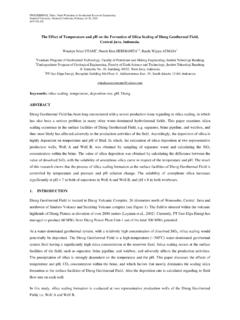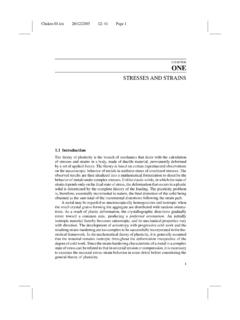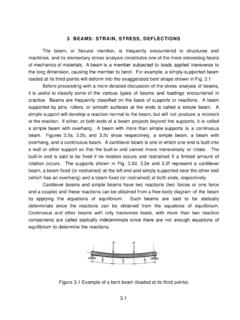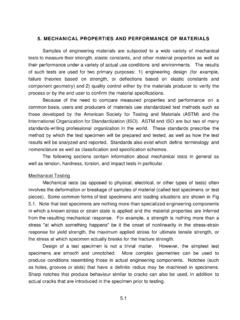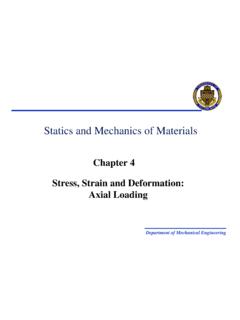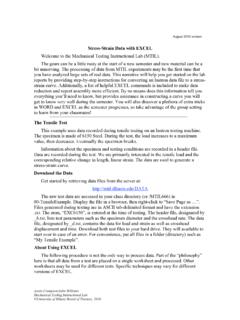Transcription of Defining Stress in a Solid
1 Stanford Rock Physics Laboratory - Gary MavkoStress and strain Analysis 30 Defining Stress in a SolidThese forces that we must apply to the cuts areexactly the forces that act within the general these forces depend on: the position within the Solid the orientation of the surfaceImagine applyingexternal forces to a an imaginary cut inside,and apply a set of forcescarefully chosen so that therest of the Solid does not feelthe forces will depend onthe position and orientation ofthe Rock Physics Laboratory - Gary MavkoStress and strain Analysis 31 When we push on something, we apply forcesto a surface. When we break something, we create break along surfaces. When we repair something, we reattach or are surfaces important?
2 Stanford Rock Physics Laboratory - Gary MavkoStress and strain Analysis 32 Look more closely at the forces acting on a surfaceThe normalized force per unit area is called theTraction Vector or Stress orientation of the surface isspecified by the outward normalvector FForce Ftangentialcomponentnormalcomponentarea dA unit normal Stanford Rock Physics Laboratory - Gary MavkoStress and strain Analysis 33 Tractions and StressesWe define the traction vector as the force per unitarea acting on a define the Stress as the set of components oftractions acting on the various surfaces. In cartesiancoordinates:xzy zz zx zy yz yy yx xx xy xzStanford Rock Physics Laboratory - Gary MavkoStress and strain Analysis 34 Units of Stress1 bar = 106 dyne/cm2 = psi10 bar = 1 MPa = 106 N/m2 Mudweight to Pressure Gradient1 psi/ft = 144 lb/ft3 = lb/gal = kPa/m1 lb/gal = psi/ftStanford Rock Physics Laboratory - Gary MavkoStress and strain Analysis 35 Traction on a Surface ofArbitrary OrientationCauchy s Formula.
3 TxTyTz= xx xy xz yx yy yz zx zy zz x y z T= Txyz =( x, y, z)Stanford Rock Physics Laboratory - Gary MavkoStress and strain Analysis 36 xx xy xz yx yy yz zx zy zz xy= yx xz= zx yz= zyThe Stress Tensor is SymmetricWe must also balance the torques applied tothe cube and we find that: Stress tensor is are only 6 independent Rock Physics Laboratory - Gary MavkoStress and strain Analysis 37 Einstein Summation ConventionIt is customary in Stress and strain analysis to usea shorthand notation, sometimes called the Einsteinsummation convention. Any repeated index withina term implies summation over that index with arange of 1 to example: cijkl kl k=13cijkl kl l=13andare equivalent. Here, k is repeated so it implies asummation; l is also repeated, so it also implies asummation.
4 I and j are not repeated so there areno summations. ij+ jkThere is no summation in this expression:because there is no repeated summation in any ofthe terms. The two occurrances of the index j arein two different Rock Physics Laboratory - Gary MavkoStress and strain Analysis 38 Transformation of CoordinatesWe found it convenient to define the elements of the stresstensor in a given coordinate system. We did so by labelingthe various components of forces that act on the faces oforthogonal planes in that coordinate now want to be able to write the Stress tensor in terms ofanother coordinate system. That is, for the same physicalconfiguration of forces, how do we simply label or describethese in terms of another set of axes? Or, how do we find thecomponents of force acting on the orthogonal planes in thenew coordinate system?
5 We do it in two steps: 1. First find the coordinate transformation that relates thetwo sets of axes. 2. Then use it to re-express the Stress tensor in the newcoordinate 'yy'x'xrStanford Rock Physics Laboratory - Gary MavkoStress and strain Analysis 39 r=x1e1+x2e2+x3e3r=x1 e1 +x2 e2 +x3 e3 Coordinate TransformationsA real physical vector can be expressed in any twocoordinate systems:It is important to remember that we are simply givingthe same physical vector different names in differentcoordinate in index notation: x1 x2 x3 = 11 12 13 21 22 23 31 32 33x1x2x3 xi = ijxj= ijxj j=13where is the direction cosine of the new ith axisrelative to the old jth for any vector we can write: ij r = r Stanford Rock Physics Laboratory - Gary MavkoStress and strain Analysis 40So now go back to Cauchy s formulaNow transform T and to the new coordinatesRewrite as:Rename term in brackets:Formula for coordinate transformation ij= ik jl kl Told= old old ijTTnew= old ijT new Tnew= ij old ijT new Tnew= new new ij old ijT= newStanford Rock Physics Laboratory - Gary MavkoStress and strain Analysis 41 The hydrostatic Stress or mean Stress is theaverage of the three normal is an invariant.
6 The mean Stress is thesame in any coordinate system. 0= xx+ yy+ zz3= 3 Stanford Rock Physics Laboratory - Gary MavkoStress and strain Analysis 42where is the magnitude of the traction vector, isthe direction, and is a is a standard problem of finding the eigenvaluesand eigenvectors of a matrix. We call the threeeigenvalues the principal stresses, and the three eigenvectors the principal directions. T ij ijPrincipal StressesStress is a real physical state or quantity: we haveforces, surfaces, and Stress whether or not we choose acoordinate system. Now, if we do define a coordinatesystem, then we assign numerical values to thecomponents in the matrix:In general, different choices of coordinate systemscause the numerical values in the matrix ( Stress tensor)to recall Cauchy s formula:Can we find directions such that the traction vector isnormal to the surface?
7 T= ij T= ij = Stanford Rock Physics Laboratory - Gary MavkoStress and strain Analysis 43 Principal StressesLet s emphasize the physical interpretation: 1000 2000 3 The traction is parallel to , which is alwaysperpendicular to the surface. If is normal to thesurface then there is no component of parallel tothe surface. Therefore, there is no shear simplest and most important thing to rememberabout the principal axes is that there are no shearstresses on surfaces perpendicular to the threeprincipal we find these directions and make them axes thenwe know how to transform the Stress tensor to theseaxes and we will find: T T TStanford Rock Physics Laboratory - Gary MavkoStress and strain Analysis 44PP'QQ'Infinitesimal strainWe can describe the deformation of a continuum witha vector displacement field.
8 This displacementgives the vector motion of each point in the is important to note that the displacement can varywith position. UStanford Rock Physics Laboratory - Gary MavkoStress and strain Analysis 45 Rigid Body TranslationThe vector displacement field is a Rock Physics Laboratory - Gary MavkoStress and strain Analysis 46 PQP'Q'Rigid Body Rotation u= r= rotation vector direction is along axis of rotation is the angle of rotation Stanford Rock Physics Laboratory - Gary MavkoStress and strain Analysis 47 StrainIf a body undergoes a displacement that cannot besimulated point-by-point as a rigid body translation orrotation, then we say it is strain we have deformation or distortion. Thesize or shape is changed.
9 U(x,y,z) (x,y,z) U(x+dx,y+dy,z+dz) (x + dx, y + dy, z + dz)Stanford Rock Physics Laboratory - Gary MavkoStress and strain Analysis 48strain=symmetric partrotation=antisymmetricpartWe usually work in the range of infinitesimal strain mathematically geophysically Ux x<< 1 Ux x<< 10 4 UxUyUzr+dr=UxUyUzr+ Ux x Ux y Ux z Uy x Uy y Uy z Uz x Uz y Uz zdxdydz Ux x Ux y Ux z Uy x Uy y Uy z Uz x Uz y Uz z= xx xy xz yx yy yz zx zy zz+0 3 2 30 1 2 10 Stanford Rock Physics Laboratory - Gary MavkoStress and strain Analysis 49 Exploring the Physical Interpretation of Strain1. Extensional StrainThe relative change in length can be described as L=L L0=Ux+dx Ux U xL0 LL0 U x xxThe strain terms along the diagonal describerelative changes in (x)U(x+dx)LoLStanford Rock Physics Laboratory - Gary MavkoStress and strain Analysis 50 Exploring the Physical Interpretation of Strain2.
10 Volumetric StrainThe original volume isThe volume after straining isThe volumetric strain is the trace of the strain tensoror is the sum of the three extensional strains. This issometimes called the dilatation. V0=Lx0Ly0Lz0 V0+ V=Lx0+ LxLy0+ LyLz0+ Lz V0+ V Lx0Ly0Lz01+ LxLx0+ LyLy0+ LzLz0 VV0 xx+ yy+ zzStanford Rock Physics Laboratory - Gary MavkoStress and strain Analysis 51 Exploring the Physical Interpretation of Strain3. Pure Shear strain = xyWhen we deform the square like this, notice that thecorner changes from a 90 angle to a lesser angle90 - 2 . Note thatFor small angles:The shear strain describes a change in tan = Ux y= Uy x tan 12 Ux y+ Uy xStanford Rock Physics Laboratory - Gary MavkoStress and strain Analysis 52 Exploring the Physical Interpretation of Strain4.




